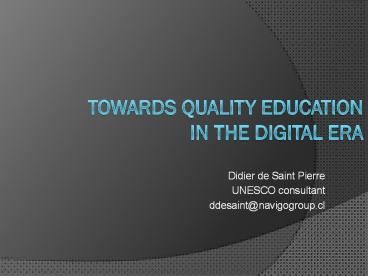Towards quality education in the digital era PowerPoint PPT Presentation
1 / 12
Title: Towards quality education in the digital era
1
Towards quality education in the digital era
- Didier de Saint Pierre
- UNESCO consultant
- ddesaint_at_navigogroup.cl
2
Technology is leading the world through rapid
chages globalization, knowledge society,
participation in social networks
3
(No Transcript)
4
New basic skills are required to face the 21st
century.
5
Todays youth have new cognitive skills they are
the digital natives.
6
The digital natives learn outside school which
is uncapable of incoorporating their learning.
7
The school we all know, which was conceived for
other times and students, faces one of its
greatest transformation challenges.
8
Is Information Technology in Education the answer
to this challenge?
- There is no concensus on the impact digital
technologies have on the students learning. - Despite that, new technologies invade everything,
even schools, and are here to stay. - How do we harness them to improve the quality of
education? - Can technology improve or add value to the
processes which impact the quality of education?
9
The scope of Information Technology in Education
Providers
Other schools
10
Conditions for ICT in education to impact learning
- A growing number of researchers believe that a
triangulation of contents, sound high quality
teaching and learning principles and models as
well as trained teachers are required to truly
impact learning by investing on Information
Technology in Education. - A digital strategy at school-level and an
information technology in education policy at
national level are required. The policy is
systemic.
11
Policy Purpose
- An ITE policy must have a stated objective
providing coherence to actions taken, such as - Close the digital divide by providing technology
literacy to all students (and teachers) - Enhance students motivation and participation
(absenteeism reduction, etc.) - Improve teaching, leadership, management and
decision making. - Improve students economic viability by
improving some of the skills related to future
greater productivity at work. - Expand learning opportunities, overcoming the
geographical constraints - Improve students curricular learning as a
consequence of better classroom conditions and
resources or as a consequence of a deep
transformation in pedagogical models. - Develop new skills, the so-called students
basic 21st century skills - Policies on Information Technology in Education
are a fundamental part of each countrys
education policies.
12
Components of ITE Policy
Resistance (e.g. unions)
MoE and TTP
Content
Country Digital Development
Teaching Skills
Infraestructure and technical support
Political will
Curriculum
Human Capital
Usage and pedagogical models
Institucionality and financial resources
Evaluation
Contents Industry
Management leadership
13
Emblematic plans/projects in the region
- Ceibal in Uruguay
- Enciclomedia in Mexico
- TEC in Chile
- National ICT Plan of Colombia
- Huascaran in Peru
- PROINFO en Brasil
14
Lessons Learned
15
Lessons Learned
- It is not the same thing to launch a project on
Information Technology in Education than to have
a policy on Information Technology in Education. - A policy on Information Technology in Education
designed from the digital agenda does not have
the same impact as one designed under the
umbrella of a policy on education. - The best technology in the world will not enhance
learning on its own in inefficient schools which
lack good work practices. Filling schools with
computers is not enough to improve results.
16
Lessons learned teachers are key
- There is evidence and large concensus on the fact
that the quality of teachers and their teachings
is the most important factor to explain students
performance. There are no clues which would
allow us to speculate that this factor might
change with the use of ICT in Education.
17
ITE Evolution Model
18
UNESCO development areas
19
Possible initiatives for LATAM
- Support ITE policy making in the region.
- Promote the inclusion of ICT and digital
resources in pedagogical processes. - Support teacher training processes in the region.
- Oversee impact assessment on ICT in education.
- Clearinghouse
20
Thank You
- Didier de Saint Pierre
- UNESCO consultant
- ddesaint_at_navigogroup.cl

